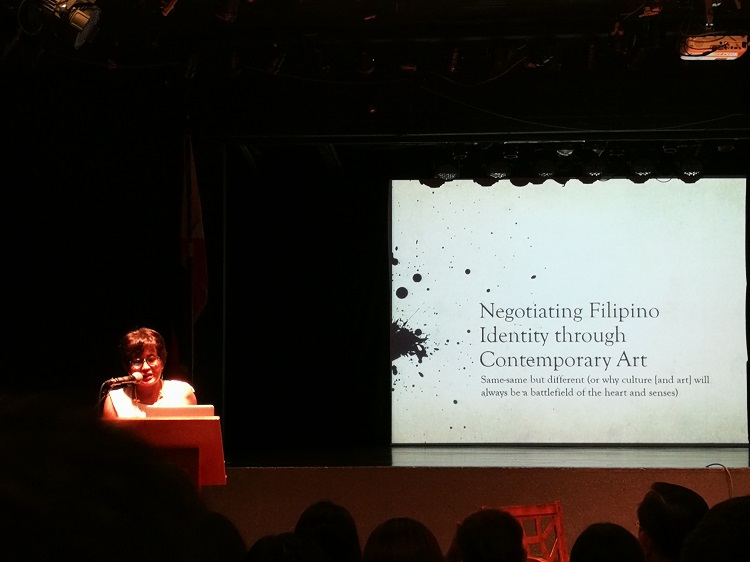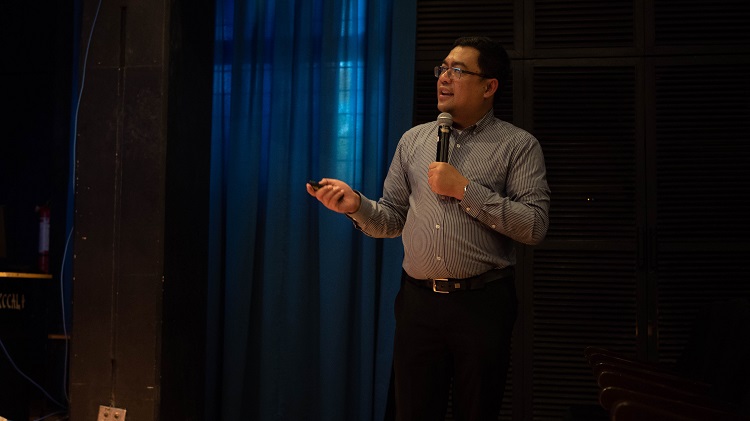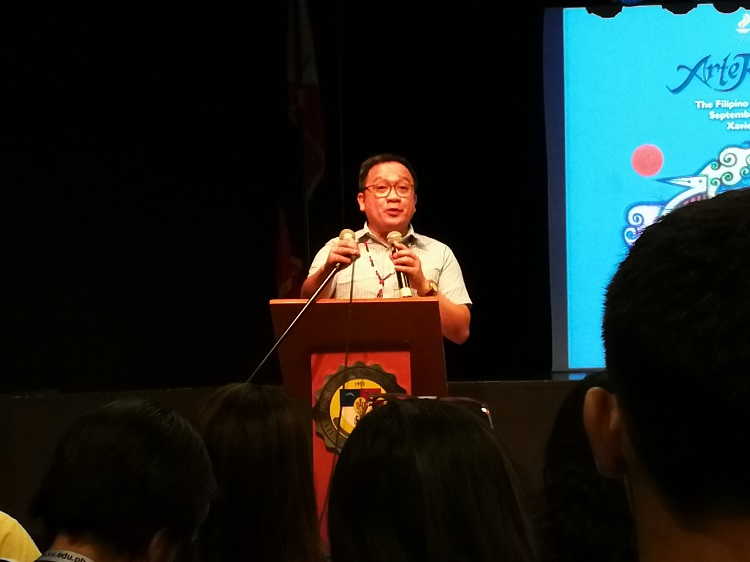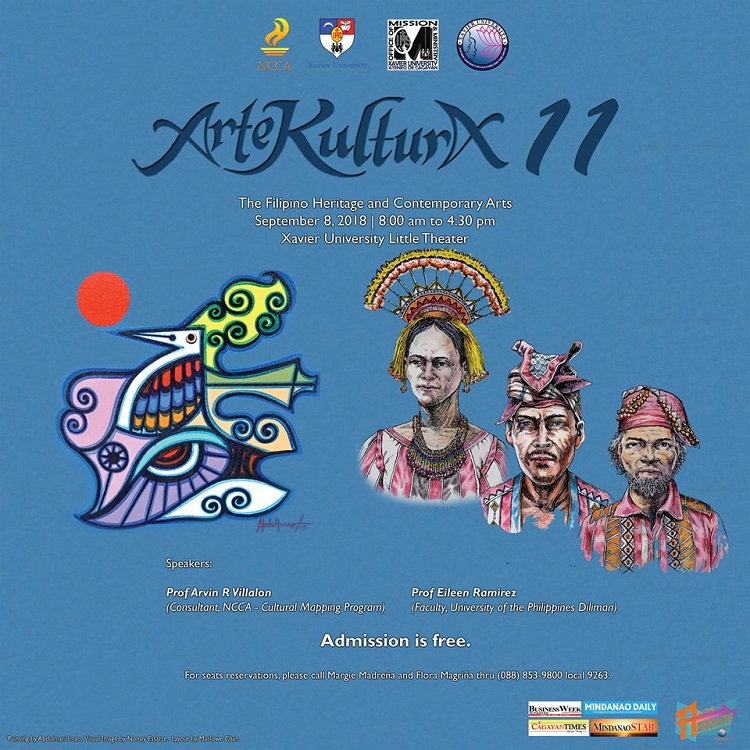
FILIPINO IDENTITY. UP Diliman Department of Arts faculty member Eileen Ramirez emphasizes the key role of contemporary art in sustaining the Filipino identity. Photo by Angelo Lorenzo
Text by Angelo Lorenzo
Heritage defines the multi-faceted Filipino identity just as art preserves this legacy in contemporary times.
In conclusion to Xavier Ateneo’s Mission and Ministry Week, the Xavier Center for Culture and the Arts (XCCA) conducted the 11th installment of Artekultura at the XU Little Theater on September 8, 2018. Attended mostly by members of the academe, students, and local artists, the conference underscored the significance of preserving heritage and culture and keeping the Filipino identity in contemporary art.
“Considering that culture and the arts are part of the pillars of sustainable development, we view them not only on the basis of entertainment, but as our way of life - one that really goes with our progress,” said XCCA director Hobart Savior.
This was mirrored by National Commission for Culture and the Arts’ (NCCA) consultant for the Cultural Mapping Project (under the Subcommission on Cultural Heritage), Arvin R Villalon in his lecture on the Filipino heritage, the first of two discussions during the conference.
Heritage as foundation
“Culture is everything; it is our way of life,” Villalon said.
Villalon highlighted that heritage, as part of our culture, is grounded on Filipino communities which are diverse in their origins. As an important part of these communities, heritage has to be protected, preserved, and sustained.
As culture exists in present times, it is the heritage that treasures its history, and on how it played an integral factor in people’s beliefs, practices, and traditions.
“A person who knows about culture will preserve some of the evidence of the present because he knows that these can be used as markers to indicate a certain period of time,” Villalon stated.
For this, he encouraged educators to introduce cultural mapping and its value to students so that they will be familiar with treasuring their heritage.
“If a thing represents your people, then it is considered heritage,” he added. A good representative of the culture of the present can be preserved through songs, music, language, or object.
Villalon enumerated entities and categories which can serve as bases for the framework of cultural mapping. The entities include material culture (referring to objects or artifacts), geographical environment (landscapes, seascapes), and human environment (buildings, monuments). On the other hand, categories consist of natural heritage, tangible heritage, and intangible heritage.
“My challenge is for millennials to bridge memories,” he quipped. “Culture is an engine for progress, and not only a thing of the past.”
Because of this, culture and heritage, as major indications of the Filipino identity, can be restored and sustained through the creative works of passionate individuals.

FILIPINO HERITAGE. National Commission for Culture and the Arts’ consultant for the Cultural Mapping Project under the Subcommission on Cultural Heritage, Arvin R Villalon expresses the significance of preserving authentic heritage and culture as the foundation of the Filipino identity in his lecture. Photo by Jeffrie Po
Identity in the contemporary
As the conference was separated into two parts, the second lecture showed the relationship between the Filipino identity and how its authenticity is represented in contemporary art.
University of the Philippines Diliman's Eileen Ramirez of the Department of Arts Studies shared how art can help preserve a nation’s identity and bring people together.
“Art is able to activate very sincere and earnest engagements or encounters with people,” she remarked. “It has its own language.”
As part of the editorial pool of “Southeast of Now: Directions of Contemporary and Modern Art in Asia” and as the editor of “Pananaw: Philippine Journal of Visual Arts,” she implied that art plays a huge role in shaping present-day society.
Because of this, artists take on the responsibility of representing the authenticity of culture through their works, apart from their expressions.
“We have to look at ourselves in an effort to deal with our identity,” Ramirez declared. “As an individual, you have your own agency, but at the same time, you are also part of a community.”
Ramirez presented the artwork of mixed-media artist Santiago Bose, which showed cartoon figures over a backdrop of a colonial event. One of the characters in the frame was Mickey Mouse which symbolizes the neocolonial mentality the West has continued to impose over modern-day Filipinos, and which the latter consciously or unconsciously adopt.
But apart from perpetuating authentic cultural identity, artists can also use their passion and skills to unite people and bring them to light from the margins.
This was accomplished by Ramirez’s collaboration with Oro Arts Guild members and recipients to the Philippine Art Awards Jake Vamenta and Michelle Lua three years ago, in which an urban poor community welcomed artists to conduct workshops. They taught and encouraged children to paint, and posted their works on walls within the center they had built.
“Contemporary art could do work like this,” she said. “Artists keep doing creative work to keep the promise that contemporary art can be meaningful.”
She added, “Artists should have the responsibility to know and care about the issues in the world.”
Like Villalon, Ramirez expressed encouragement for educators to anchor their students in the impact that art can ignite for sustainable development, where culture and identity are preserved.
“Both artists and educators are in a powerful place to promote culture through art,” she indicated.

MULTIDISCIPLINARY INITIATIVE. XCCA director Hobart Savior highlights the relevance of preserving heritage and culture and promoting the arts as not only exclusive to cultural workers and artists but are also initiatives to engage a variety of professions. Photo by Angelo Lorenzo
Multidisciplinary initiative
Recognizing heritage and culture and representing identity are initiatives that are not exclusive to artists, cultural workers, and the academe.
Since these are shared by the community, anyone part of it can take initiative. As the conference offered free admission, it maintained its objective for inclusivity.
“We wanted Artekultura to be in a more interdisciplinary or transdisciplinary level,” Savior explained. “We try to look at arts in terms of psychology, engineering (etc), and relate them into multidisciplinary facets.”
Regardless of disciplines or professions, it is the identity that defines a Filipino, and heritage and culture that elaborate it.
“Culture is important,” Villalon stated, to which Ramirez related with, “Artists need to seek to be involved.”∎

ARTS AND CULTURE. This year’s Artekultura tackles about the importance of heritage preservation and sustaining the Filipino identity in contemporary times. Image supplied by XCCA